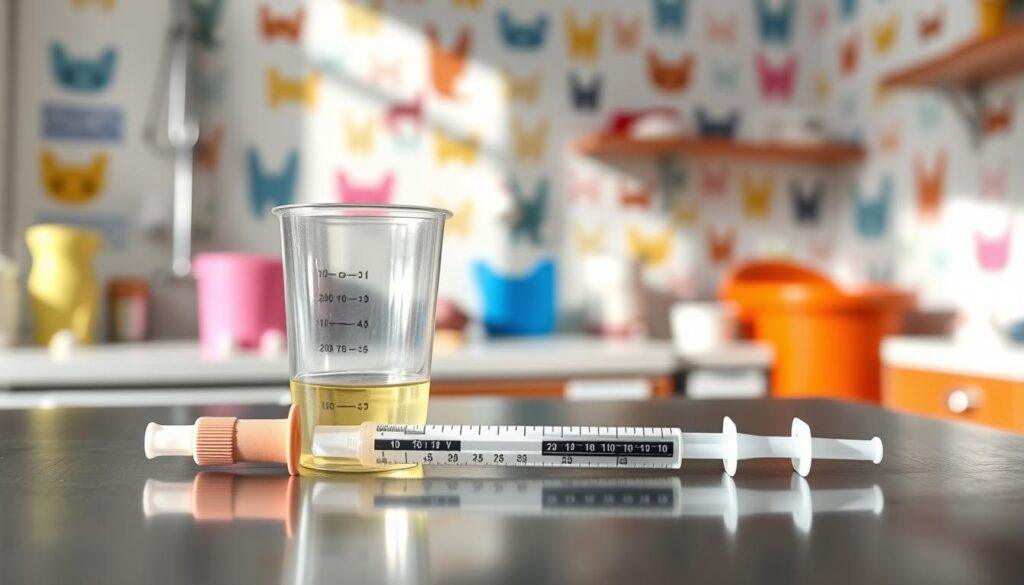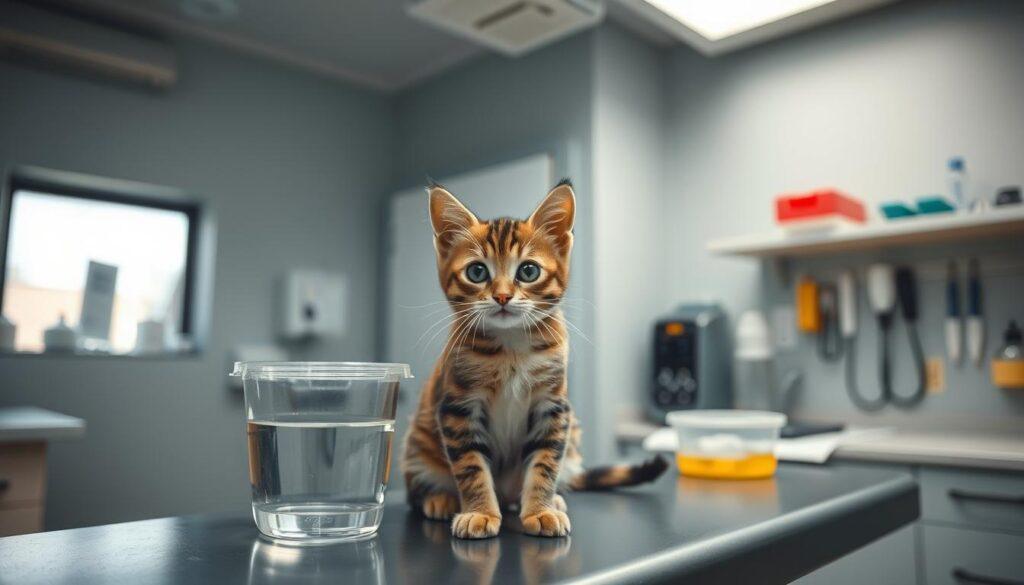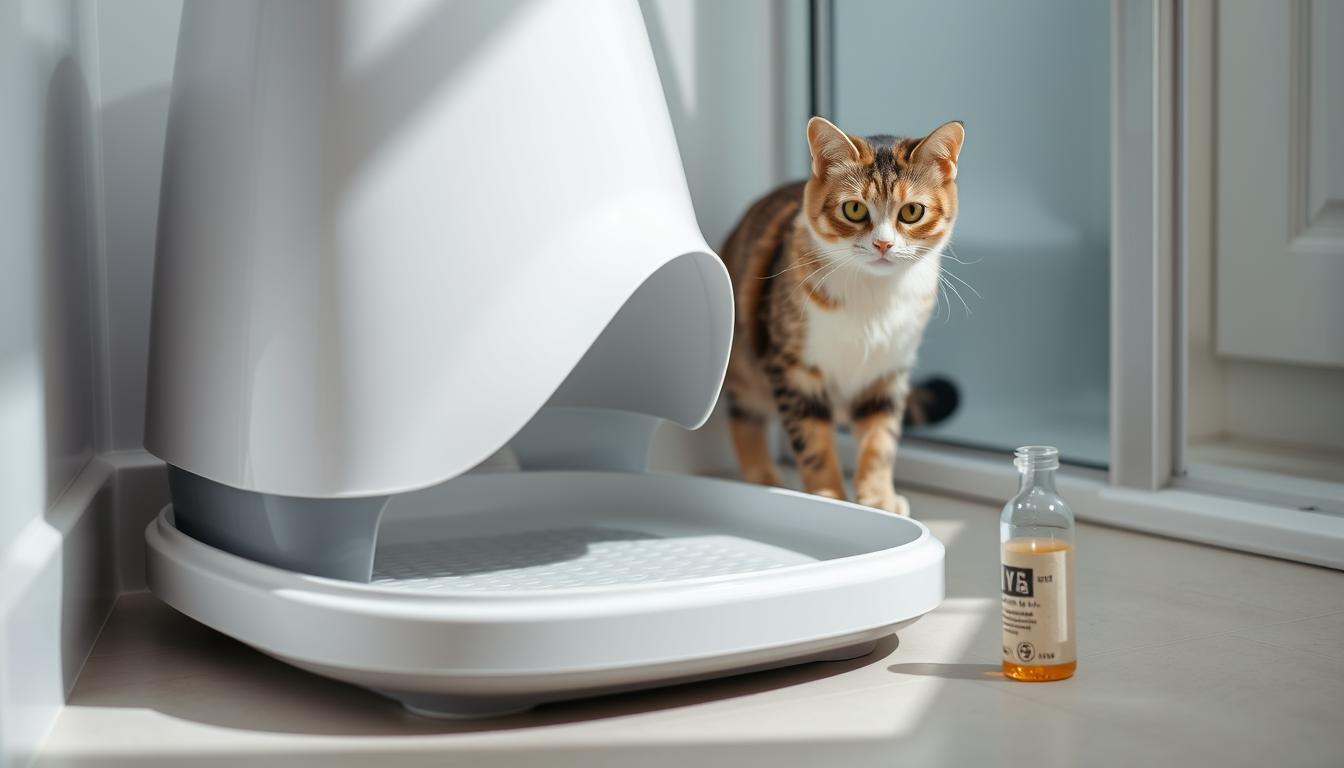If your vet asks for a feline urine sample, it might mean your cat is sick. Changes in your cat’s bathroom habits could signal a health problem. Most vets want a fresh urine sample for testing1.
A urine sample is vital for diagnosing issues like urinary tract infections, kidney problems, or diabetes1.
Getting a clean cat urine sample can be tough. Vets need it fresh, at the right temperature, and in a sterile container. They usually need about 1-2 ml of urine, but it depends on the tests1.
To collect a urine sample, you can use a sample pot, a dropper, a clean litterbox, or non-absorbent litter. Beaded cat litter test kits make it easier, as they don’t absorb urine12.
After collecting the urine, take it to the vet within 12 hours for accurate results2. If you can’t get a sample, your vet might help. They could leave the cat at the clinic or do a procedure to get urine from the bladder1.
It’s best to take the sample to the vet within 2 hours. After 24 hours in the fridge, throw it away and get a new one3.
Key Takeaways
- A fresh, clean urine sample is crucial for accurate diagnosis of feline health issues
- Various methods exist for collecting a cat urine sample, including specialized litter and containers
- Urine samples should be delivered to the vet within 12 hours of collection for best results
- Refrigerate the sample if it cannot be delivered immediately, but discard after 24 hours
- Consult your vet for assistance if you have difficulty obtaining a urine sample from your cat
Why Your Vet Needs a Clean Urine Sample
Getting a clean cat urine sample is key for your vet to check your cat’s health. A cat urinalysis helps your vet find and track health issues. This ensures your cat gets the best care.
Diagnosing Urinary Tract Infections (UTIs)
Older cats often get urinary tract infections. These can be found in urine samples with bacteria and white blood cells4. Your vet can spot these signs and start treatment with antibiotics.
Identifying Bladder Stones or Crystals
Urinary crystals can lead to infections and stones. Your vet will look at the urine sample for crystals or stones4. This helps them know if your cat needs diet changes, antibiotics, or surgery.

Monitoring Kidney Function and Hydration Status
A cat urinalysis shows how well your cat’s kidneys are working and if they’re hydrated. If the urine is too dilute, it might mean kidney disease4. Your vet will check for protein and urine concentration to spot kidney disease early.
Vets check urine in three ways: looking at color and clarity, using test strips for glucose and blood, and examining under a microscope for cells and bacteria4. This detailed check helps find and fix health problems quickly.
| Condition | Urine Sample Indicators |
|---|---|
| Urinary Tract Infection | Bacteria, white blood cells |
| Bladder Stones/Crystals | Presence of crystals |
| Kidney Disease | Dilute urine, protein levels |
| Diabetes | Glucose in urine |
It’s important to get a urine sample within 12-16 hours for accurate results5. Dirty samples can mess up the test. So, getting a clean sample is crucial for your vet to analyze.
The Importance of a Fresh Urine Sample
Getting a fresh urine sample is key for accurate cat urine tests. As time goes by, urine can change a lot. These changes can make test results wrong6. Bacteria in urine can grow fast, doubling every 20-40 minutes in warm conditions7.
Urine tests are very useful for cats. They help check the health of your pet. Tests can find problems like infections, stones, and even cancer8. It’s vital to use a fresh urine sample for the best results.
Changes in Urine Composition Over Time
Urine changes when it sits at room temperature. These changes can mess up test results:
- It can get cloudy and form crystals
- An ammonia smell may appear due to bacteria
- The pH level can shift, changing the chemical makeup
- Red and white blood cells can break down, making infections hard to spot
These changes can lead to wrong diagnoses and bad treatment plans. To avoid this, it’s important to get a fresh urine sample and take it to your vet quickly.
Bacterial Growth and False Diagnoses
Old urine samples can grow bacteria fast. This can make it seem like your cat has a UTI7. This might mean your cat gets antibiotics they don’t need, which can make bacteria resistant to drugs.

To stop bacteria growth, keep the urine cold if you can’t get to the vet right away8. But, even cold samples should be tested within 24 hours for the best results.
| Urine Sample Age | Potential Changes | Impact on Test Results |
|---|---|---|
| Fresh (less than 1 hour) | Minimal changes | Accurate results |
| 1-4 hours | Bacterial growth, pH changes | Potential false positives for UTIs |
| 4+ hours | Significant bacterial growth, cell breakdown | Inaccurate results, false diagnoses |
Knowing the importance of a fresh urine sample helps pet owners get the right diagnosis and treatment for their cats. Always ask your vet for help with urine samples if you’re unsure68.
Preparing for Urine Collection
Getting a cat urine sample for a test is all about preparation. First, get a sterile container from your vet. This keeps the sample clean and accurate for your cat’s health check.
Make sure your cat has fresh water and watch for signs they need to pee. If your cat goes outside, bring their litter box inside for easier collection9. Use a clean litter box with a bit of clean litter or torn paper. Or, your vet might suggest non-absorbent litter, but check first to make sure it’s clean enough.
Obtaining a Sterile Collection Container
A sterile container is key to avoid contamination. Your vet will give you one with instructions. It’s important to follow these steps to get accurate results for your cat’s test.
| Container Type | Characteristics | Advantages |
|---|---|---|
| Plastic | Lightweight, durable | Easy to transport, less likely to break |
| Glass | Transparent, non-porous | Allows for visual inspection, prevents contamination |
| Specialized Kit | Includes cups with lids and wipes | Provides all necessary components for clean collection |
Encouraging Your Cat to Urinate
Timing is everything when how to get cat urine sample. Urine samples are good for testing for only 6 hours10. So, plan your vet visit for when you can collect the sample10. Encourage your cat to drink water and watch for signs they need to pee.
If your cat is hard to get urine from, your vet might suggest special litter or ways to empty the bladder.
After collecting the urine, put it in the sterile container quickly for the best test results10. With the right prep and timing, you can get a clean sample that helps understand your cat’s health.
How to Get Cat Urine Sample: Step-by-Step Guide
Getting a urine sample from your cat is key for diagnosing and treating urinary and kidney problems11. It’s best to get a fresh sample, like the first morning urine11. Here’s how to do it:
- Follow your cat to the litter box and hold a clean, shallow container between their legs to catch the urine stream.
- If your cat prefers to urinate on a bathroom rug, wait patiently and catch the urine as they go.
- Use a clean, empty litter box in its usual spot. If your cat objects, add a small amount of clean litter or torn paper. Plastic beads can also be used to prevent urine absorption11.
- If you can’t catch the sample in time, wait several hours before trying again or ask your vet if you can leave your cat in their care for the day.
You can also use urine testing strips for a home test without special equipment12. These strips can spot urinary tract infections (UTIs) by looking for leukocytes and nitrites12.
Your vet might suggest a cystocentesis to get a clean urine sample from your cat’s bladder. This is the best way for urinalysis and culture tests, especially for bacterial cystitis13. But, it might cause temporary blood in the urine and should only be done by a pro13.
After getting the urine sample, keep it cold if you can’t get to the vet right away11. The sample should be less than 12 hours old for the best results11.
Remember, keeping an eye on your cat’s urinary health is vital for their well-being. By following these steps and working with your vet, you can catch and treat problems early.
Handling and Storing the Collected Sample
After getting your cat’s urine sample, it’s key to handle and store it right. This ensures accurate cat urine testing results. First, wash your hands well. Then, label the container with your name, your cat’s name, and the collection date and time14.
This info is vital for your vet to analyze the sample right. They can then give you an accurate diagnosis.
Proper Labeling and Refrigeration
It’s crucial to store the veterinary urine sample in the fridge (not freezer) until you see your vet14. Refrigeration stops bacteria growth. It keeps the sample’s quality, making test results more reliable.
Getting the urine sample to your vet quickly is important. It helps get reliable test results and solve health problems fast.
Timely Delivery to Your Veterinarian
Try to get the sample to your vet within 24 hours. If you can’t, keep it cold in a fridge. Most vets need 1-2 ml of urine for tests. But, some tests might need more15.
By following these steps, you help your vet get the best sample for diagnosis. Early action is key for your cat’s urinary health and overall well-being.
When to Seek Your Vet’s Assistance
If getting a clean urine sample from your cat is tough, it’s time to see your vet. They can help diagnose issues like bladder infections, stress cystitis, kidney disease, bladder stones, and diabetes14. Your vet might suggest keeping your cat at the clinic for a day. This way, they can get the sample using special methods.
Cystocentesis: A Clean Sample Method
One method is cystocentesis, where they take urine directly from the bladder with a needle and syringe14. This method gives a clean sample for testing. Many tests can be done at the vet’s office, while others need to go to a lab14.
Proper Handling of Home-Collected Urine Samples
When you collect urine at home, remember that cells can grow fast in warm urine. This can make tests less accurate16. It’s best to get the sample to the vet quickly, within 24 hours. Keep it in the fridge but not frozen, or use a cooler16.
Make sure to label the urine sample with your cat’s and your details, along with when and where you got it14. If the sample is over 24 hours old, get a new one for better results4. Try to give the new sample to the vet within an hour, or refrigerate it if you can’t4.
Some things vets check in urine include:
- Concentration
- Glucose levels (indicating diabetes)
- Protein
- Blood
- Inflammatory cells (indicating bladder inflammation)14
Vets look at urine color and clarity, use special strips for sugar and blood, and examine it under a microscope for cells, bacteria, and crystals4. Getting a clean urine sample from your cat is key to finding health problems early and treating them well16.
| Condition | Urine Test Indication |
|---|---|
| Stress Cystitis | Most common cause of bladder inflammation among cats4 |
| Urinary Tract Infections (UTIs) | Common in older cats4 |
| Urinary Crystals | Can lead to painful conditions, including UTIs and stone formation4 |
| Kidney Disease | Diluted urine can be a sign4 |
| Diabetes | Presence of glucose and ketones in urine may indicate diabetes4 |
| Hematuria (Blood in Urine) | Could indicate various underlying health conditions requiring urgent attention4 |
Remember, if you’re ever unsure about how to proceed with obtaining cat urine or interpreting your cat’s urinalysis results, don’t hesitate to reach out to your veterinarian for expert advice and support.
Conclusion
Getting a urine sample from your cat is key to keeping their urinary tract healthy. It helps check for infections, diabetes, kidney issues, and overall health17. Make sure to collect a clean, fresh sample of 5 to 10 milliliters in a dry container17.
Morning is the best time to collect urine for a full bladder. Using non-absorbent litters like Nosorb, PawCheck, and Kit4Cat can help18.
After getting a cat uti sample, handle it carefully. Take it to the vet quickly, within 15-30 minutes18. If you can’t get there fast, refrigerate it but use it within 24 hours for best results1817.
Remember, urine pH and bacteria counts can change quickly. This could lead to wrong diagnoses of urinary tract infections18.
Collecting urine at home is safe if done right17. But, if you’re unsure or worried, always ask your vet for help. Regular vet visits, care, and pet insurance are also important for your cat’s health. By following the right steps for collecting and handling a urine sample, you can help your vet diagnose and treat your pet correctly.
FAQ
How can I encourage my cat to urinate for a sample?
Why is a fresh urine sample important for accurate test results?
What can a clean urine sample tell my vet about my cat’s health?
How should I store and transport my cat’s urine sample?
What if I’m unable to collect a urine sample from my cat?
Source Links
- How to Get a Urine Sample From a Cat: Effective Vet Approved Tips & FAQ – Catster – https://www.catster.com/cat-health-care/how-to-get-urine-sample-from-cat/
- How to Collect a Urine Sample from Your Cat: A Step-by-Step Guide – https://www.companionanimalvet.com.au/askthevet/cats/how-collect-urine-sample-your-cat-step-step-guide
- How to Get Urine Sample From a Cat: 7 Expert Tips & Tricks | PangoVet – https://pangovet.com/pet-health-wellness/cats/how-to-get-urine-sample-from-a-cat/
- How to get a urine sample from a cat – https://www.myfamilyvets.co.uk/collecting-urine-sample-from-your-cat
- Urine Sample – Cat – https://www.towncountryvet.com/forms/urine-sample-cat
- Urinalysis for Cats and Dogs: Why Is It Important? – https://www.petmd.com/procedure/urinalysis-for-cats-and-dogs
- Why Does My Vet Want a Urine Sample from My Cat? – https://www.pethealthnetwork.com/cat-health/cat-checkups-preventive-care/why-does-my-vet-want-a-urine-sample-my-cat
- Urine tests in cats | Joii Pet Care – https://www.joiipetcare.com/health-conditions/cat/urine-tests/
- Clean catch urine sample: MedlinePlus Medical Encyclopedia – https://medlineplus.gov/ency/article/007487.htm
- How To Collect Your Pet’s Urine Sample – https://www.brookfarmveterinarycenter.com/post/collect-urine-sample
- Take a Urine Sample – Cornwallis Road Animal Hospital – https://cornwallispetcare.com/take-a-urine-sample/
- Urinalysis for Pets: How At-Home Urine Testing Can Benefit Your Pet’s Health – https://www.diagnoxhealth.com/blog/urinalysis-for-pets?srsltid=AfmBOor92l5MjaSlCIXE-miw4gdE-qUfFLetaJpk7QFM5Yl70JemOwMi
- Performing Cystocentesis in Dogs & Cats | Clinician’s Brief – https://www.cliniciansbrief.com/article/cystocentesis
- How to collect a urine sample from your cat – https://www.pdsa.org.uk/pet-help-and-advice/pet-health-hub/other-veterinary-advice/how-to-collect-a-urine-sample-from-your-cat
- How to collect a cat urine sample – our best tips – Rochford Vets – https://www.rochfordvets.co.uk/how-to-collect-a-cat-urine-sample/
- How to Get a Urine Sample from a Cat | Learn How to Collect Cat Urine & Get a Sample with Ease – https://www.embracepetinsurance.com/waterbowl/article/feline-urine-sample
- How to Get a Urine Sample from a Cat – https://vocal.media/petlife/how-to-get-a-urine-sample-from-a-cat
- How To Get Urine Sample From Cat: Techniques For Collecting Feline Urine Samples – Cat Boarding Hotel Laguna, Mission Viejo, Anaheim, Santa Ana, CA | Cats Luv Us – https://www.catsluvus.com/cat-care/how-to-get-urine-sample-from-cat-techniques-for-collecting-feline-urine-samples/


